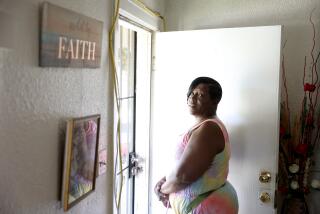Blue Cross Plans Getting Mixed Financial Prognosis : Health: Demise of insurance unit in West Virginia is not considered unique. High costs, competition, outdated regulations are blamed.
Even before Blue Cross and Blue Shield of West Virginia went bankrupt last fall, state Insurance Commissioner Hanley Clarkâs phone was busy with calls from worried officials in other states.
âThere are commissioners who are very much concerned about the financial status of the Blue Cross plan in their states,â Clark said. âI donât think we were unique. There are a lot of worried people across the country.â
The demise of the West Virginia plan, which stuck policyholders with $53 million in unpaid medical bills, marked the first time a âBlues planâ has gone bust. But the reasons for the failure are not unique to the state.
Soaring medical costs, competition from commercial insurers and outdated state regulations--criticized as both too weak and too strong--have pushed several of the nationâs Blues plans into the danger zone.
Earlier this year Blue Cross and Blue Shield of New Jersey was $105 million in the red; the national Blue Cross & Blue Shield Assn. was threatening to pull its certification.
Another eight plans, including those in Maryland, Massachusetts, New Hampshire, New York, Rhode Island and Vermont, are either in the red or have less than a month of cash reserves on hand, a general indication of a plan in financial trouble.
While most plans, including New Jersey, have seen some improvement, the prognosis is mixed. Experts still fret about an expected downturn in the insurance business cycle and continued pressure from commercial competition.
âAny insurer going into the downturn without a reasonable amount of reserves is in trouble,â said Preston Jordan, senior vice president of the Blue Cross & Blue Shield Assn. âThere are going to be more mergers and more failures unless they are in good financial shape.â
Even if all survive, many Blues will emerge significantly changed. Industry officials foresee fewer, larger Blues plans operating more like hard-nosed commercial carriers and less in the Blue Cross tradition of providing insurance to all.
âMore and more of the Blues are being forced into taking on some of these practices that make it harder for people to get insurance,â said Jordan.
Blue Cross-Blue Shield plans pioneered private health insurance in this country during the Depression. They grew rapidly after World War II, spurred by tax incentives and federal rules that made health care a chip in collective bargaining.
There were as many as 130 community-based Blue Cross and Blue Shield plans. A succession of mergers brought the number down to 73.
More than 71 million Americans are covered by a Blues plan. Another 30 million people are covered by Medicare, Medicaid or public employee plans administered by a Blues.
But Blues plans have been losing ground. In 1960s they controlled 35% of the burgeoning health insurance market; they now have 27% and continue to lose ground to commercial insurers.
The Blues traditionally set prices based on âcommunity rating,â bundling together medical costs of an entire community and spreading the risk equally. Customers paid similar rates no matter what their demographic or medical risk might be. Insurance was available to all comers.
But increasingly, commercial carriers have gnawed away at the Blues base through âcherry picking.â In that rating process, the young and healthy are offered significantly lower rates while the sick and elderly get stuck with greatly increased premiums or are denied coverage entirely.
Healthy policyholders abandoned the Blues for the better commercial rates, leaving the plans with a bigger percentage of high-risk customers.
âWe tried to be very benevolent at the same time the market was becoming extremely competitive. The allegiance and loyalty from the customers werenât there,â said Clark Dumont, vice president for public affairs at Blue Cross and Blue Shield of New Hampshire.
But some say the Blues are not entirely blameless. Many plans traded on their social contract for legislative exemption from the financial safety margins required of commercial carriers.
âThe Blues have been successful in lobbying legislatures,â said David Gates, a former Nevada insurance commissioner and president of the National Assn. of Insurance Commissioners. âIn some states they are the major health insurer and that brings some weight with it.â
One example: Only 16 states require Blues to pay into guarantee associations. These associations of state insurers provide funds in case one of the members is unable to pay claims.
West Virginia Blue Cross and Blue Shield was exempt from the guarantee association. So some 276,000 customersâ remain unpaid. Doctors, hospitals and other providers are now demanding that the policyholders make good on the bills.
âItâs very sad for the consumer,â Clark said. âThey pay in good faith and expect their claims to be paid. The protection they thought they had is not there.â
Most states require insurance companies to set aside cash reserves in case of a downturn in revenues. But many states mandate that the Blues use a portion of the extra cash to lower rates.
âHistorically, many of the plans in this area of the country were managed by state law with a social plan to have minimal capital levels,â said Douglas McIntosh, president of Rhode Island Blue Cross & Blue Shield, which had less than a week of cash to handle claims at the end of last year. State law limited them to one month of reserves.
âAs a nonprofit entity, that seemed like a sufficient amount of capital to remain solvent,â he said. âIn this day and age when you can have the million-dollar baby case, AIDS cases and transplants, the volatility of medical care is so much higher.â
The Rhode Island plan has since received legislative mandate to build a three-month reserve fund.
Some plans have fought back against commercial rating competition. Vermont and Oregon, have supported successful legislation that requires commercial plans to set rates the way the Blues have traditionally done.
âWe had an unwritten social contract with the state to serve as an insurer of last resort,â said Jay Shak, senior vice president of marketing for the Vermont plan. âIn our view this is a return to the tradition.â
But many more Blues plans are adopting the tactics of commercial carriers. Only 22 plans still use a community rating system. Empire Blue Cross-Blue Shield of New York recently asked permission to switch to the demographic and medical ratings systems of the commercial carriers.
Many in the industry see a continuing consolidation of state plans into regional Blue Cross-Blue Shield operations, a move that would allow better competition with the large commercial carriers.
âMy expectations would be we would have as few as a dozen in 10 years,â said David Kikumoto, senior vice president for marketing at Rocky Mountain Health Care Corp., the Blue Cross and Blue Shield plan for Colorado, Nevada and New Mexico.
But Jordan of the national association cautions that the Blues, with their tradition of supplying insurance to all, must not become too much like their commercial competitors.
âUnless something is done to reform the more damaging rating practices, weâre going to be forced in that direction and make the problem of the uninsured and uninsurables worse.â
More to Read
Sign up for Essential California
The most important California stories and recommendations in your inbox every morning.
You may occasionally receive promotional content from the Los Angeles Times.










